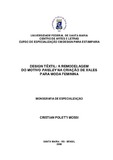| dc.contributor.advisor | Aquistapasse, Lusa Rosangela Lopes | |
| dc.creator | Mossi, Cristian Poletti | |
| dc.date.accessioned | 2017-05-19T13:28:58Z | |
| dc.date.available | 2017-05-19T13:28:58Z | |
| dc.date.issued | 2008 | |
| dc.date.submitted | 2008 | |
| dc.identifier.uri | http://repositorio.ufsm.br/handle/1/2910 | |
| dc.description | Monografia (especialização) - Universidade Federal de Santa Maria, Centro de Artes e Letras, Curso de Especialização em Design para Estamparia, RS, 2009. | por |
| dc.description.abstract | Starting from the presupposition that man has always created objects aiming
at stylizing its day by day and establishing, thus, its material culture, which is also
composed, amongst other elements, by its textiles that besides recovering and
protecting its body also work as social and cultural differentiators, the present
research had the main purpose of remodeling the motif known as Paisley and from
that creating shawls for feminine fashion appropriate to the current textile design
market. There are several theories for the true origin and signification of the
proposed motif, however, what is known is that it was brought from India by British
soldiers when they returned from the east wars, during the Industrial Revolution, in
the XIX century, and presented their wives with long wool clothes from Cachemira
where such format was weaved. Ever since, the Paisley motif has been used in the
ornamentation of the most varied surfaces, especially in the contemporanity, which
favors multiple and several cultural appropriations and (re)visitations in design, in
fashion and in the most varied visual productions, it appears in several ways and still
with great acceptation. The creative process of this investigation, based on the
intercrossing of the methodologies proposed by Mike Baxter (2000) – “Visual
Dashboard” Tool – and by Luiz Vidal Negreiros Gomes (2001) – Steps to the
Creative Process – has grounded the inventive path of the shawls collection which is
separated, according to specific characteristics, in three distinct lines that are
complemented to each other. The first one, based on mango (referential applied by
the indigenous culture for creating the Paisley motif), constitutes the Paisley
Mangífera summer line, the second one, based on pinecone (referential applied by
the Scottish culture for creating the Paisley motif), constitutes the Paisley Araucaria
winter line and the third one, named Paisley Origin, which have no specific use
season and is based on the drawing resultant from the hybridization of both
referential. Such research reached good results, presenting both a drawing for
stamping and a collection of shawls highly differentiated in relation to those that are
currently found. | eng |
| dc.language | por | por |
| dc.publisher | Universidade Federal de Santa Maria | por |
| dc.rights | Acesso Aberto | por |
| dc.subject | Design têxtil | por |
| dc.subject | Motivo Paisley | por |
| dc.subject | Xale para moda feminina | por |
| dc.subject | Processo criativo | por |
| dc.title | Design têxtil: a remodelagem do motivo Paisley na criação de xales para moda feminina | por |
| dc.title.alternative | Textile design: the remodeling of the Paisley motif in the making of shawls for feminine fashion | eng |
| dc.type | Trabalho de Conclusão de Curso de Especialização | por |
| dc.degree.local | Santa Maria, RS, Brasil. | por |
| dc.degree.specialization | Design para Estamparia | por |
| dc.description.resumo | Partindo do pressuposto que o homem sempre criou objetos com o intuito de
estilizar seu cotidiano, instituindo assim sua cultura material, a qual está composta,
entre outros elementos, também por seus têxteis que servem tanto para recobrir e
proteger seu corpo, quanto como diferenciação cultural e social, esta pesquisa teve
por objetivo principal remodelar o motivo conhecido por Paisley e a partir disso, criar
xales para moda feminina, congruentes com o mercado do design têxtil atual. Há
inúmeras teorias para a verdadeira origem e significação do motivo proposto, porém
o que se sabe é que ele foi trazido da Índia pelos soldados britânicos que voltavam
das guerras no oriente durante a Revolução Industrial no século XIX e presenteavam
suas mulheres com longos xales de lã da Cachemira, onde tal formato era tecido.
Desde então, o motivo Paisley fora utilizado na ornamentação das mais variadas
superfícies e especialmente na contemporaneidade, momento que favorece
múltiplas e diversas apropriações e (re)visitações culturais no design, na moda e nas
mais variadas produções visuais, o mesmo apresenta-se de diversos modos e ainda
com grande aceitação. O processo criativo desta investigação, pautado no
entrecruzamento das metodologias propostas por Mike Baxter (2000) - Ferramenta
‘Painel Visual’ - e por Luiz Vidal Negreiros Gomes (2001) – Passos para o Processo
Criativo – fundamentaram o percurso inventivo da coleção de xales, a qual se divide,
de acordo com características específicas, em três linhas distintas, porém que se
complementam entre si. A primeira, com base na manga (referencial utilizado para a
criação do motivo Paisley pela cultura indiana), constitui a linha de verão Paisley
Mangífera, a segunda, baseada na pinha (referencial utilizado para a criação do
motivo Paisley pela cultura escocesa), constitui a linha de inverno Paisley Araucária
e a terceira, nomeada Paisley Origem, a qual não tem estação de uso específica e
baseia-se no desenho resultante da hibridação de ambos os referenciais. Considerase
que tal pesquisa alcançou bons resultados, apresentando tanto um desenho para
estampagem quanto um conjunto de xales bastante diferenciados do que se
encontra atualmente. | por |
| dc.publisher.unidade | Centro de Artes e Letras | por |


